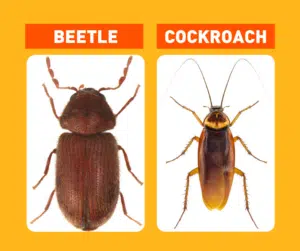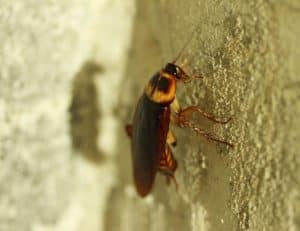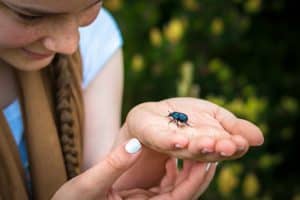Cockroach or Beetle – Which One is in Your Home?
By: Lisa Dingeman
Homeowners are not happy to find either a beetle or cockroach infestation in or near their homes. While neither is a house guest you want, it’s good to know the difference between the two insects so you can use proper pest control measures to get rid of them and prevent them from returning.
Each insect that enters your home can carry with it a large number of diseases. So along with learning how to identify a cockroach vs beetle, this article will also give you some helpful tips on pest prevention so you can keep these creepy crawlers away from you and your family.
How to Identify a Cockroach
Males and females differ in color from reddish-brown to dark brown. They have 6 long legs and much longer antennae than other insects. At first glance, they appear to have hard shells (exoskeletons) on the back of their bodies, when in fact the shell is more of a papery, leather texture, not solid at all. The shell is there to protect the wings from destruction.
The body can be broken up into 3 different sections, the head, thorax, and abdomen. In some large types of cockroaches, the males possess a double set of wings while the females do not possess wings at all.
The head contains large eyes and long antennae. An adult can measure from 1-2 inches in length. With over 3,500 identified species of cockroaches, roughly 10 of those are considered a household pest.
The diet of a cockroach leaves little to the imagination — their food sources are essentially unlimited. They will eat almost anything — including meats, sweets and starches, skin, hair, paper, and any organism dead or alive. Nothing is off-limits to a cockroach.
How to Identify a Beetle
Most beetles possess two sets of wings, with the stiff, outer set used to protect the inside wings which are used for flying. But not all beetles can fly. They have six legs. Ground beetles have a similar appearance and are commonly mistaken for roaches, even though they have smaller heads.
With 400,000 different species of beetles, some look like cockroaches but their sizes range from 6 inches in length all the way down to 1/16th of an inch. Most are vibrant in color and very pretty—like the ladybug —while others are black, light brown, or reddish-brown like the June bug.
Beetles can be a problem in the household and can cause significant damage to agriculture, forestry, and horticulture. Their diet depends on the type, but most will eat leaves, wood, seeds, or carpet, while others may eat fungus or feces. Here’s a list of the most common types of beetles you will find in a household.
[subscription-form gfid=”15″ text=”Keep your home pest free with simple, effective solutions. Subscribe and save!” tag=”Cockroaches”]
Identifying Signs of Cockroach and Beetle Damage
At first glance, cockroaches and beetles may seem to be very similar insects, however, there are several key ways to tell these two insects apart. Cockroaches also have flattened bodies, while beetles tend to be more cylindrical in shape. In addition, beetles typically have short antennae while cockroaches have long antennae.
The damage these two insects cause will likely differ. If your home has a beetle or cockroach problem, here are the different types of damage possible:
Damage Caused by Cockroaches
Cockroaches, of any stage, can spread bacteria and diseases to you and your family. Their saliva and waste can contaminate your food, which can result in food poisoning and cause infections. Studies show that they may harbor viruses and bacteria such as salmonella, staphylococcus, and the polio virus. They can also cause allergies, depending on the level of infestation.
Roaches primarily feed on starchy items but have been known to consume whatever is edible to them. They will find cereals and like products, as well as anything that is left out, to eat in your home. Larger cockroaches will damage paper products and glue, such as book bindings, and have even eaten wallpaper.
Cockroaches will probably not be seen until there is an infestation, so if you see one, it’s likely you already have a large issue on hand. Because they are nocturnal, they prefer to seek a food source at night. They’ve been known to cause a musty odor — the more apparent the odor, the bigger the problem. They will leave behind feces that resemble coffee grounds or specks of pepper. As the roach gets bigger, the waste will appear to be more like an oval pellet. If you spot a large amount of feces, you have a big problem on your hands.
Damage Caused by Beetles
Most destruction caused by beetles is from their larvae. Larvae could be found at home, inside sheds, or in other structures containing wood or carpet. The wood-boring beetle can live in wood for up to 10 years, without any obvious signs. Once you have spotted a full-grown beetle in your home, it is probably too late to prevent any damage.
Damage caused by carpet beetles is often mistaken for clothes moths. They have mandibles, or two hard teeth in the front of their mouth, and they are able to chew through leather, carpet, any type of cloth, and even dead organisms. An adult beetle will feed on plant-based fibers in gardens and around the home, eating light-colored petals. While they do not spread disease, if left untreated, they can cause expensive problems to your home and property.
Beetles may find their way into your home for different reasons — they may be seeking shelter, or they may catch a ride on something carried in. They will typically stay close to their natural habitat around plants or floral arrangements. Others will be found around fibers like cloth or leather, seat cushions, furs or hides, or around your kitchen. The larvae can be found in hidden and undisturbed areas, such as behind baseboards, under floorboards, and under heavy objects like furniture.
Preventing a Serious Problem
Before calling an exterminator, help eliminate these pests from your house by taking away their food supply and water source. Keep surfaces clean of extra food waste and store pantry food in airtight containers. You should also keep your garbage locked and airtight.
Patch up any openings that roaches or any other type of insect could be using to gain entrance, such as window cracks, cracks in door frames, etc. Natural repellents, like bay leaves, cucumber slices, and garlic have been used to rid areas of cockroaches. By placing them on countertops, in pantries, or wherever you are experiencing a serious problem, you will leave your home smelling fresh while getting rid of the pesky insects. If you prefer a ‘set it and forget it’ approach, place a few pouches of Stay Away® Ants & Cockroaches in areas needing protection from pests.











 day
day